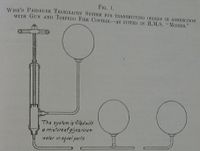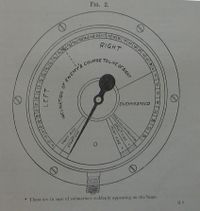Wise Pressure Telegraphy System

Wise's Pressure Telegraphy System was an hydraulically actuated system of remotely indicating fire and torpedo control information between different stations on a ship.
It was based on existing patents held by Engineer Lieutenant Commander A. S. Wise and adapted by Engineer Lieutenant Commander F. S. Carlisle of H.M.S. Morris, a new ship which lacked a means of communicating ranges from the bridge to guns.[2]
Original Concept
It was a Ouija board, in effect.
The system was a simple one of using a hydraulic medium of half glycerine and half water to communicate between stations. The transmitter was a screw-valve and a repeat indicating gauge, and one or more remote indicating gauges to act as receivers. In effect, the man working the transmitter could indicate the meaning of any one of a number of messages arrayed around the circumference of the identical gauge dials.
The first installation used only rigid piping, which placed some limitations on where the gauges could be placed. It proved highly reliable in nine months of service under all weather conditions.[3]
Adapted for Torpedo Control

By the end of 1915, Captain (D) of the Tenth Destroyer Flotilla (Captain Wilmot S. Nicholson) had suggested that the system be adapted for torpedo control. Under this scheme, the dial's indications were no longer a simple scalar, as it was when conveying ranges, but had several regions for various purposes. Rather, the dial was as shown to the right, allowing enemy inclination, enemy speed, and simple training and firing orders to be communicated.
See Also
Footnotes
- ↑ Annual Report of the Torpedo School, 1915, Figure 1, p. 243.
- ↑ Annual Report of the Torpedo School, 1915, pp. 242-243.
- ↑ Annual Report of the Torpedo School, 1915, p. 244.
- ↑ Annual Report of the Torpedo School, 1915, Figure 2, p. 243.
Bibliography